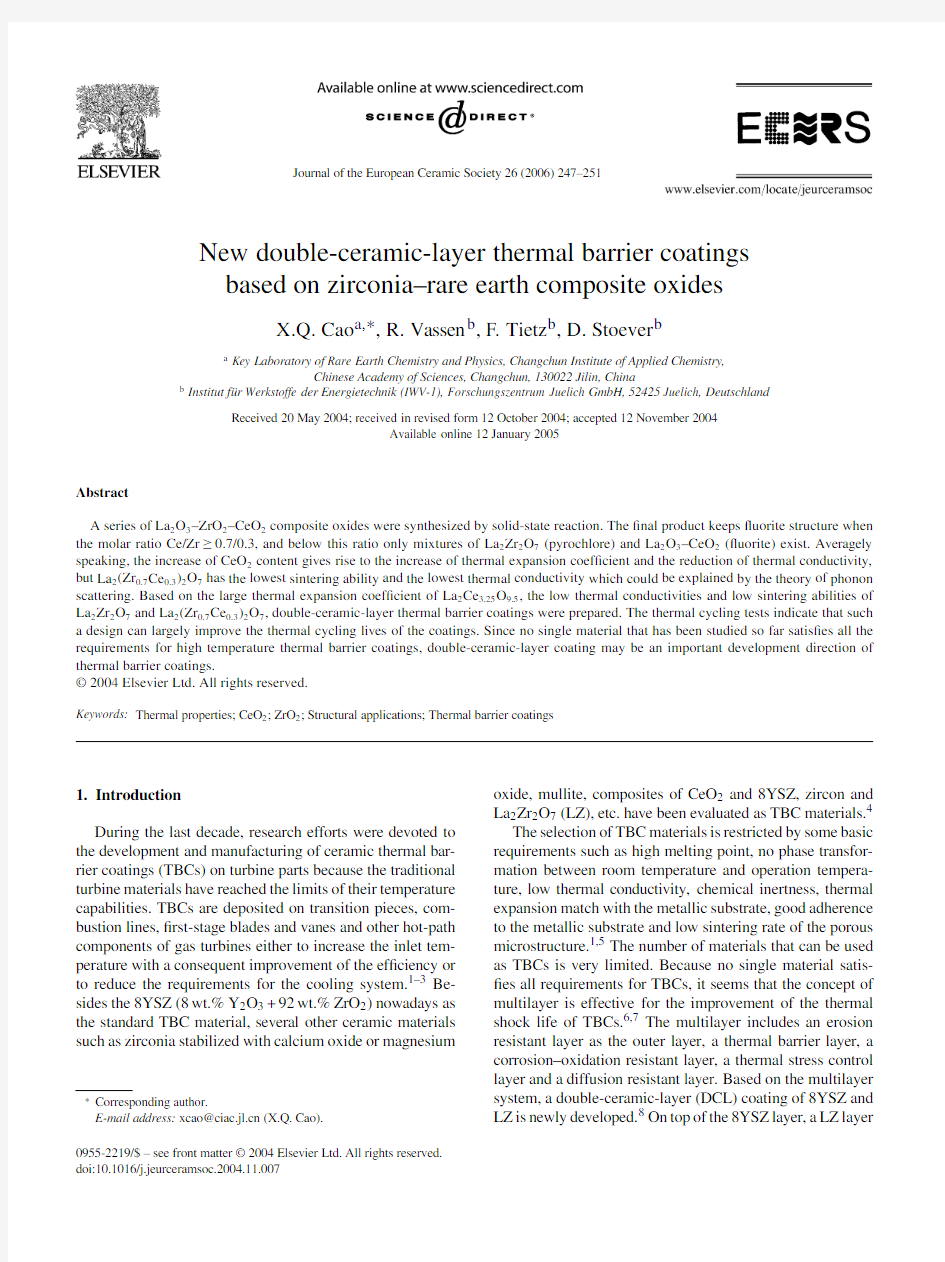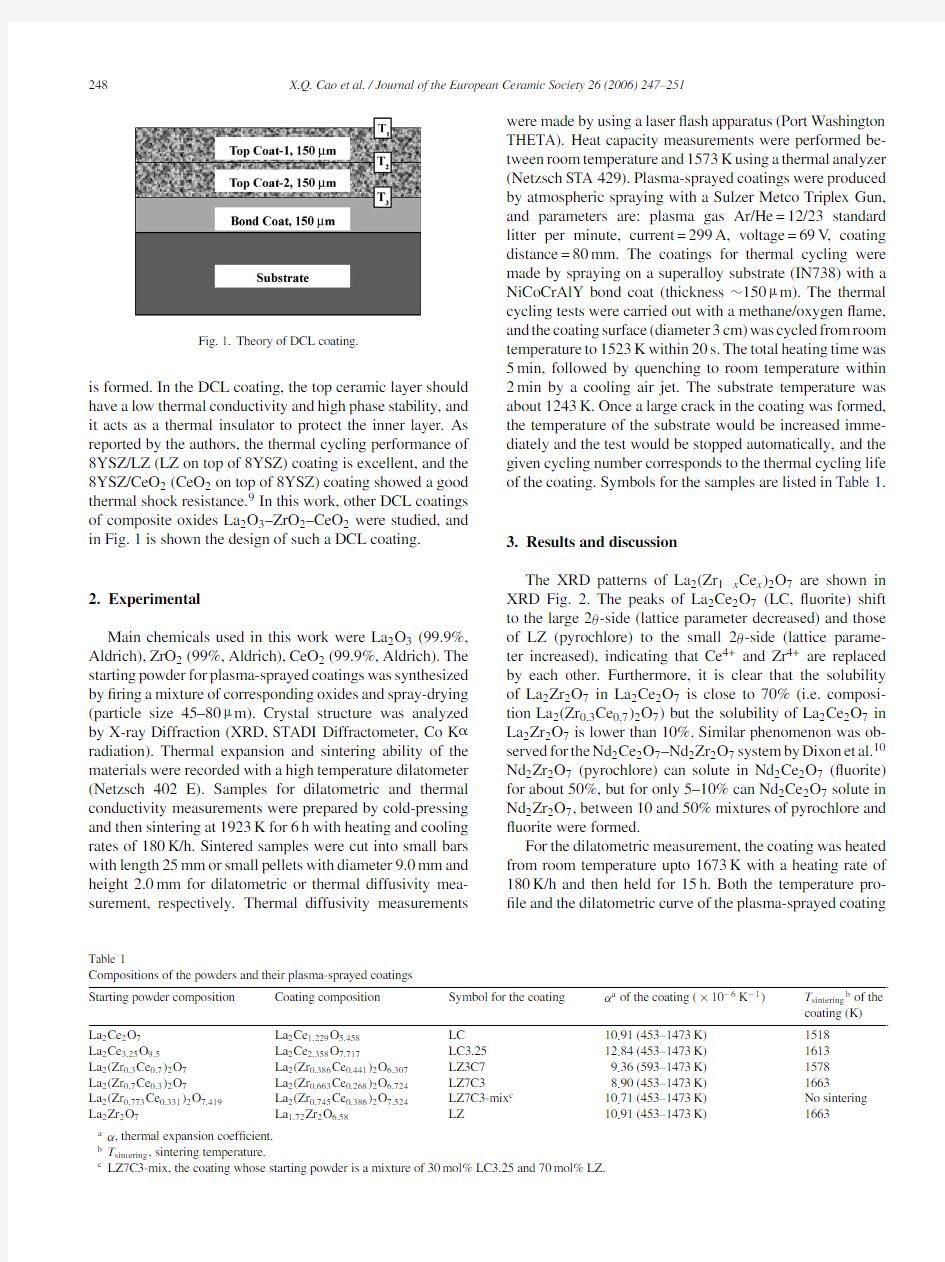

Journal of the European Ceramic Society26(2006)
247–251
New double-ceramic-layer thermal barrier coatings
based on zirconia–rare earth composite oxides
X.Q.Cao a,?,R.Vassen b,F.Tietz b,D.Stoever b
a Key Laboratory of Rare Earth Chemistry and Physics,Changchun Institute of Applied Chemistry,
Chinese Academy of Sciences,Changchun,130022Jilin,China
b Institut f¨u r Werkstoffe der Energietechnik(IWV-1),Forschungszentrum Juelich GmbH,52425Juelich,Deutschland
Received20May2004;received in revised form12October2004;accepted12November2004
Available online12January2005
Abstract
A series of La2O3–ZrO2–CeO2composite oxides were synthesized by solid-state reaction.The?nal product keeps?uorite structure when the molar ratio Ce/Zr≥0.7/0.3,and below this ratio only mixtures of La2Zr2O7(pyrochlore)and La2O3–CeO2(?uorite)exist.Averagely speaking,the increase of CeO2content gives rise to the increase of thermal expansion coef?cient and the reduction of thermal conductivity, but La2(Zr0.7Ce0.3)2O7has the lowest sintering ability and the lowest thermal conductivity which could be explained by the theory of phonon scattering.Based on the large thermal expansion coef?cient of La2Ce3.25O9.5,the low thermal conductivities and low sintering abilities of La2Zr2O7and La2(Zr0.7Ce0.3)2O7,double-ceramic-layer thermal barrier coatings were prepared.The thermal cycling tests indicate that such a design can largely improve the thermal cycling lives of the coatings.Since no single material that has been studied so far satis?es all the requirements for high temperature thermal barrier coatings,double-ceramic-layer coating may be an important development direction of thermal barrier coatings.
?2004Elsevier Ltd.All rights reserved.
Keywords:Thermal properties;CeO2;ZrO2;Structural applications;Thermal barrier coatings
1.Introduction
During the last decade,research efforts were devoted to the development and manufacturing of ceramic thermal bar-rier coatings(TBCs)on turbine parts because the traditional turbine materials have reached the limits of their temperature capabilities.TBCs are deposited on transition pieces,com-bustion lines,?rst-stage blades and vanes and other hot-path components of gas turbines either to increase the inlet tem-perature with a consequent improvement of the ef?ciency or to reduce the requirements for the cooling system.1–3Be-sides the8YSZ(8wt.%Y2O3+92wt.%ZrO2)nowadays as the standard TBC material,several other ceramic materials such as zirconia stabilized with calcium oxide or magnesium ?Corresponding author.
E-mail address:xcao@https://www.doczj.com/doc/233302585.html,(X.Q.Cao).oxide,mullite,composites of CeO2and8YSZ,zircon and La2Zr2O7(LZ),etc.have been evaluated as TBC materials.4 The selection of TBC materials is restricted by some basic requirements such as high melting point,no phase transfor-mation between room temperature and operation tempera-ture,low thermal conductivity,chemical inertness,thermal expansion match with the metallic substrate,good adherence to the metallic substrate and low sintering rate of the porous microstructure.1,5The number of materials that can be used as TBCs is very limited.Because no single material satis-?es all requirements for TBCs,it seems that the concept of multilayer is effective for the improvement of the thermal shock life of TBCs.6,7The multilayer includes an erosion resistant layer as the outer layer,a thermal barrier layer,a corrosion–oxidation resistant layer,a thermal stress control layer and a diffusion resistant layer.Based on the multilayer system,a double-ceramic-layer(DCL)coating of8YSZ and LZ is newly developed.8On top of the8YSZ layer,a LZ layer
0955-2219/$–see front matter?2004Elsevier Ltd.All rights reserved. doi:10.1016/j.jeurceramsoc.2004.11.007
248X.Q.Cao et al./Journal of the European Ceramic Society26(2006)
247–251
Fig.1.Theory of DCL coating.
is formed.In the DCL coating,the top ceramic layer should have a low thermal conductivity and high phase stability,and it acts as a thermal insulator to protect the inner layer.As reported by the authors,the thermal cycling performance of 8YSZ/LZ(LZ on top of8YSZ)coating is excellent,and the 8YSZ/CeO2(CeO2on top of8YSZ)coating showed a good thermal shock resistance.9In this work,other DCL coatings of composite oxides La2O3–ZrO2–CeO2were studied,and in Fig.1is shown the design of such a DCL coating.
2.Experimental
Main chemicals used in this work were La2O3(99.9%, Aldrich),ZrO2(99%,Aldrich),CeO2(99.9%,Aldrich).The starting powder for plasma-sprayed coatings was synthesized by?ring a mixture of corresponding oxides and spray-drying (particle size45–80?m).Crystal structure was analyzed by X-ray Diffraction(XRD,STADI Diffractometer,Co K?radiation).Thermal expansion and sintering ability of the materials were recorded with a high temperature dilatometer (Netzsch402E).Samples for dilatometric and thermal conductivity measurements were prepared by cold-pressing and then sintering at1923K for6h with heating and cooling rates of180K/h.Sintered samples were cut into small bars with length25mm or small pellets with diameter9.0mm and height2.0mm for dilatometric or thermal diffusivity mea-surement,respectively.Thermal diffusivity measurements were made by using a laser?ash apparatus(Port Washington THETA).Heat capacity measurements were performed be-tween room temperature and1573K using a thermal analyzer (Netzsch STA429).Plasma-sprayed coatings were produced by atmospheric spraying with a Sulzer Metco Triplex Gun, and parameters are:plasma gas Ar/He=12/23standard litter per minute,current=299A,voltage=69V,coating distance=80mm.The coatings for thermal cycling were made by spraying on a superalloy substrate(IN738)with a NiCoCrAlY bond coat(thickness~150?m).The thermal cycling tests were carried out with a methane/oxygen?ame, and the coating surface(diameter3cm)was cycled from room temperature to1523K within20s.The total heating time was 5min,followed by quenching to room temperature within 2min by a cooling air jet.The substrate temperature was about1243K.Once a large crack in the coating was formed, the temperature of the substrate would be increased imme-diately and the test would be stopped automatically,and the given cycling number corresponds to the thermal cycling life of the coating.Symbols for the samples are listed in Table1.
3.Results and discussion
The XRD patterns of La2(Zr1?x Ce x)2O7are shown in XRD Fig.2.The peaks of La2Ce2O7(LC,?uorite)shift to the large2θ-side(lattice parameter decreased)and those of LZ(pyrochlore)to the small2θ-side(lattice parame-ter increased),indicating that Ce4+and Zr4+are replaced by each other.Furthermore,it is clear that the solubility of La2Zr2O7in La2Ce2O7is close to70%(https://www.doczj.com/doc/233302585.html,posi-tion La2(Zr0.3Ce0.7)2O7)but the solubility of La2Ce2O7in La2Zr2O7is lower than10%.Similar phenomenon was ob-served for the Nd2Ce2O7–Nd2Zr2O7system by Dixon et al.10 Nd2Zr2O7(pyrochlore)can solute in Nd2Ce2O7(?uorite) for about50%,but for only5–10%can Nd2Ce2O7solute in Nd2Zr2O7,between10and50%mixtures of pyrochlore and ?uorite were formed.
For the dilatometric measurement,the coating was heated from room temperature upto1673K with a heating rate of 180K/h and then held for15h.Both the temperature pro-?le and the dilatometric curve of the plasma-sprayed coating
Table1
Compositions of the powders and their plasma-sprayed coatings
Starting powder composition Coating composition Symbol for the coatingαa of the coating(×10?6K?1)T sintering b of the
coating(K)
La2Ce2O7La2Ce1.229O5.458LC10.91(453–1473K)1518
La2Ce3.25O9.5La2Ce2.358O7.717LC3.2512.84(453–1473K)1613
La2(Zr0.3Ce0.7)2O7La2(Zr0.386Ce0.441)2O6.307LZ3C79.36(593–1473K)1578
La2(Zr0.7Ce0.3)2O7La2(Zr0.663Ce0.268)2O6.724LZ7C38.90(453–1473K)1663
La2(Zr0.773Ce0.331)2O7.419La2(Zr0.745Ce0.386)2O7.524LZ7C3-mix c10.71(453–1473K)No sintering La2Zr2O7La1.72Zr2O6.58LZ10.91(453–1473K)1663
aα,thermal expansion coef?cient.
b T sintering,sintering temperature.
c LZ7C3-mix,the coating whose starting powder is a mixture of30mol%LC3.25and70mol%LZ.
X.Q.Cao et al./Journal of the European Ceramic Society 26(2006)247–251
249
Fig.2.XRD patterns of La 2(Zr 1?x Ce x )2O 7,Co K ?radiation.Symbols P and F for pyrochlore and ?uorite-type structures,respectively.
are shown in Fig.3.In the dilatometric curve,the maximum temperature at which the coating begins to contract instead of expansion is named as “sintering temperature,T sintering ”.The sintering temperatures of these coatings are listed in Table 1.The coating LC has a higher sintering ability than LZ and normally the sintering ability increases with the increase
of
Fig.3.Dilatometric measurements of La 2(Zr 1?x Ce x )2O 7plasma-sprayed
coatings.
Fig.4.Thermal diffusivities of La 2(Zr 1?x Ce x )2O 7as functions of tempera-ture.
CeO 2content.However,it is very interesting to ?nd that the coating in which the Zr/Ce ratio is 0.7/0.3has the lowest sintering ability and even the coating LZ7C3-mix slightly expands instead of shrinking.On the other hand,the sample in which the Zr/Ce ratio is 0.7/0.3has the lowest thermal diffusivity (Fig.4).The thermal diffusivity decreases with the increase of temperature till about 1450K followed by a slight increase.The thermal conduction can be explained by the theory of phonon scattering.In ceramics,heat transport via phonons (lattice vibrations)are the major mechanism of thermal conductivity.11For La 2(Zr 1?x Ce x )2O 7,this mech-anism seems to be dominant below 1450K and above this temperature the radiation effect becomes more signi?cant.The composite material usually has a lower thermal conduc-tivity than those of pure materials due to the reduction of free path length of the phonons.According to this mecha-nism,in ceramics made of solid solutions or composites,the regularity of the crystal structure is altered and the phonons are more scattered resulting in a decrease of conductivity.As shown in Fig.2,LZ3C7is nearly a pure material with ?uorite structure and its thermal conductivity is lower than that of LZ and higher than that of LC,but LZ7C3is a composite of LZ and LC and therefore it is not curious that it has the lowest thermal https://www.doczj.com/doc/233302585.html,posites of CeO 2with 5–20wt.%
Table 2
Thermal cycling lives of DCL coatings Coating
Life (cycles to failure)LC3.25(339?m)29LZ7C3-mix (305?m)
120LC3.25(105?m)/LZ7C3-mix (185?m)225LC3.25(113?m)/LZ (181?m)150LZ
35
250X.Q.Cao et al./Journal of the European Ceramic Society 26(2006)
247–251
Fig.5.Surface photographs and microstructures of coatings after thermal cycling:(a)LZ;(b)LC3.25;(c–f)LC3.25/LZ,central part before thermal cycling (d),central part (e)and rim (f)after thermal cycling.
Al 2O 3also have lower thermal diffusivities than pure CeO 2and Al 2O 3even though pure Al 2O 3has high thermal diffu-sivity and CeO 2has a low value.12
Due to the large thermal expansion coef?cient of LC3.25,the low sintering ability and low thermal conductivity of LZ7C3and LZ,it is a great hope that these materials will exhibit new layered coatings with the LZ7C3or LZ coating on top of the LC3.25coating for good thermal protection.The coating design is shown in Fig.1.The top coating material is either LZ7C3or LZ.If the ther-mal cycling condition is T 1/T 3=1523K/1243K,then the surface temperature of the LC3.25layer (T 2)should be 1393K which is about 225K lower than its sintering tem-perature (1618K).The calculation is based on the ther-mal conductivities of LZ7C3(0.52W m ?1K ?1,relative den-sity ±70%,150?m)and LC3.25(0.6W m ?1K ?1,relative density ±70%,150?m).The steady state heat conduction obeys the following equation:
j =?λ
d T d l
where j is the heat ?ux;λ,thermal conductivity;T ,tempera-ture and l ,thickness of the coating.
The coating experiments arrangement and the thermal cy-cling lives of those coatings are compared in Table 2.
For comparison,the photographs of LZ,LC3.25and LC3.25/LZ after thermal cycling are shown in Fig.5.The crack within the LZ coating looks like that the whole coat-ing spalls off the substrate,which can be explained by the small thermal expansion coef?cient and low toughness of LZ.Both DCL coatings of LC3.25/LZ and LC3.25/LZ7C3-mix spalled mainly at the interface between the top layer and the bottom layer.As shown in Fig.5c,the coating LC3.25/LZ failed at the rim where a thin layer of the coating,namely LC3.25,can still be observed on the substrate.The mi-crostructures before and after thermal cycling are compared in Fig.5d–f.The crack of the coating at the rim seems to be
X.Q.Cao et al./Journal of the European Ceramic Society26(2006)247–251251
a result of thermal expansion mismatch between LC3.25and LZ.
4.Conclusion
The thermal cycling lives of LC3.25coating,LZ7C3-mix coating and LZ coating are short,but their DCL coatings can largely improve their lives,indicating that this is an ef?cient way to use the advantages and overcome the disadvantages of coating materials.This may be a new development direc-tion of TBCs.For the here tested DCL coatings,the thermal expansion mismatch between the top and bottom coating ma-terials is the main failure mechanism.Between these two lay-ers,if a functionally graded coating is formed,this problem would be hopefully reduced.
Acknowledgements
The authors thank Mr.W.Reichert(Forschungszentrum Juelich,FZJ,Germany)for XRD measurements,Mr.W.Jun-gen for spray-drying,Mr.Karl-Heinz Rauwald and Mr.Ralf Laufs(FZJ)for their invaluable assistance during plasma spraying and thermal cycling tests.Main experiments in this paper were carried out in FZJ and the rest work was?nished in Changchun Institute of Applied Chemistry and?nancially supported by“Bai Ren”&“863”Projects(2002AA332010). References
1.Cernuschi,F.,Bianchi,P.,Leoni,M.and Scardi,P.,Thermal diffu-
sivity/microstructure relationship in Y-PSZ thermal barrier coatings.
J.Therm.Spray Technol.,1999,8(1),102–109.
2.DeMasi-Marcin,J.T.and Gupta, D.K.,Protective coatings
in the gas turbine engine.Surf.Coat.Technol.,1994,68/69, 1–9.
3.Wigren,J.and Pejryd,L.,Thermal barrier coatings-why,how,where
and where to.In Proceedings of the15th International Thermal Spray Conference:Thermal Spray Meeting the Challenges of the21st Cen-tury,ed.C.Coddet.ASM International,Materials Park,OH,USA, 1998,pp.1531–1542.
4.Cao,X.Q.,Vassen,R.and Stoever,D.,Ceramic materials for thermal
barrier coatings.J.Eur.Ceram.Soc.,2004,24,1–10.
5.Vassen,R.,Tietz,F.,Kerkhof,G.and Stoever,D.,New materials
for advanced thermal barrier coatings.In Proceedings of the6th Liege Conference on Materials for Advanced Power Engineering, ed.J.Lecomte-Beckers,F.Schubert and P.J.Ennis.Forschungszen-trum Juelich GmbH,Juelich,Deutschland,1998,pp.1627–1635.
6.Tamura,M.,Takahashi,M.,Ishii,J.,Suzuki,K.,Sato,M.
and Shimomura,K.,Multilayered thermal barrier coating for land-based gas turbines.J.Therm.Spray Technol.,1999,8(1), 68–72.
7.Takahashi,M.,Itoh,Y.and Miyazaki,M.,Thermal barrier coatings
design for gas turbine.In Proceedings of14th International Thermal Spraying(Vol1),ed.A.Ohmori.High Temperature Society of Japan, Kobe,Japan,1995,pp.83–88.
8.Vassen,R.,Dietrich,M.,Lehmann,H.,Cao,X.,Pracht,G.,Tietz,
F.et al.,Development of oxide ceramics for an application as TBC.
Mater.Sci.Eng.Technol.,2001,32(8),673–677.
9.Wilden,J.and Wank, A.,Application study on ceria based ther-
mal barrier coatings.Mater.Sci.Eng.Technol.,2001,32(8),654–659.
10.Dixon,S.,Marr,J.,Lachowski, E. E.,Gard,J. A.and Glasser,
F.P.,Preparation and properties of some phases in the sys-
tem Nd2O3–CeO2–ZrO2–RuO2.Mater.Res.Bull.,1980,15(12), 1811–1816.
11.Van Vlack,L.H.,Thermal properties and high-temperature behaviour.
In Physical Ceramics for Engineering.Addison-Wesley,1964, p.140.
12.Vassen,R.,Cao,X.,Tietz,F.,Basu,D.and Stoever,D.,Zirconates
as new materials for thermal barrier coatings.J.Am.Ceram.Soc., 2000,83(8),2023–2028.